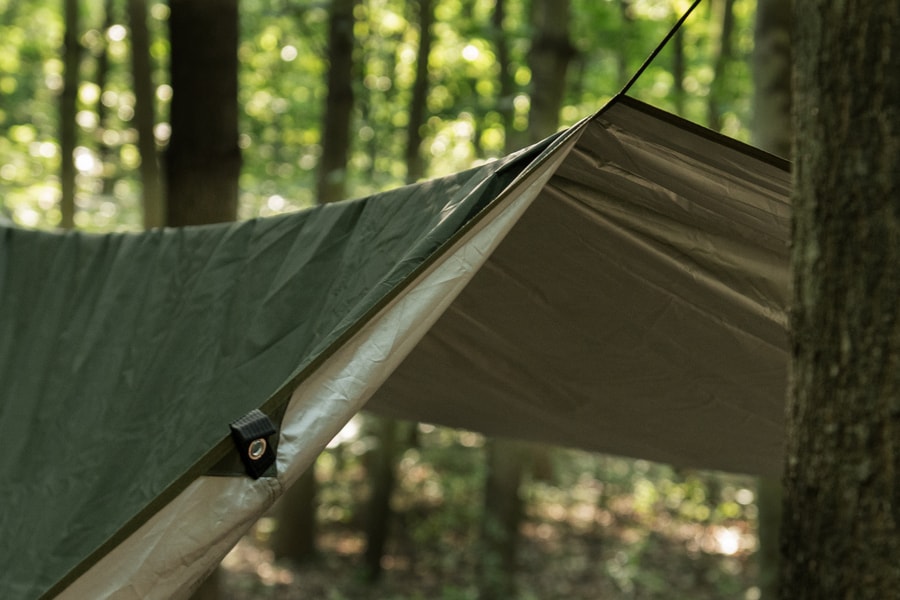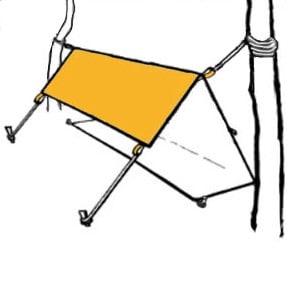Tarp - what is it and which model to choose?
Overnight stays on outdoor expeditions are most often associated with sleeping in a tent. A tent is the classic form of shelter that provides protection from the elements and creates a place where we can rest. However, there is also a lighter and more easily transportable alternative, the hiking tarp. A tarp, like a tent, provides shelter, but is much lighter and provides more freedom to choose where to sleep.
If you're wondering what exactly a tarp is and which model to choose for your expedition, then this guide is for you!
What is a tarp?
A tarp, otherwise a camping tarp, is usually a piece of fabric in the form of a rectangle or square, which is equipped with mounting points and fastening lines. Unlike a traditional tent, a camping tarp is a large sheet, usually made of durable polyester or nylon. It is also known by other names, such as tourist tarpaulin or basha.
Tourist tarp protects against rain, snow, wind and UV radiation (UVA and UVB). Some models can also function as a rescue blanket (NRC foil). Tarps come in various sizes and colors, although most often it is black, shades of green or camouflage.

How to lay out the tarp?
The camping sheet can be unfolded and attached in various configurations and places, depending on the conditions and preferences of the user. Thanks to this, tarps are more versatile (than e.g. tents) and can be adapted to a specific terrain situation.
How to lay out the tarp? Below we present several different options for spreading the bivouac tarp.
Trekking poles, guy lines and pins, which are often included with the tarp, will be useful to break up the tarp. If necessary, telescopic poles and pins can even be replaced with branches and sharpened sticks.
Variant A
If you want to pitch the tarp in variant A, choose a place where there are two trees in close proximity to each other (the distance should correspond to the length of the tarp). Thread the guy line through the mounting eyes of the tarp and attach it to the trees. Then stretch the tarp and check whether the height at which it was hung is appropriate. If you do not see any irregularities, thread more guy lines on the free sides of the sheet and fix them to the ground with pins. If you spread the tarp on trekking poles, place them at a distance that corresponds to the length of the tarp. You can stabilize the poles using guy lines. Then stretch the sides of the camping tarp and anchor them to the ground.

Variant B
In variant B, breaking up the tarp should start with making the "floor". To do this, anchor 1/4 of the tarp to the ground using the mounting eyelets on the edges of the tarp. Then stretch the guy line between the two trees at a height of about 70 cm and attach the tarp to it. Tighten the loose part of the sheet and anchor it to the ground with guy lines and pins.

Variant C
When unfastening the tarp as shown in the graphic, follow the instructions in variant B. The only difference is the height of the tarp unfastening on the rope. In this case, attach it to the trees at a height of 140 cm.

Variant D
To hang the tarp in variant D, use a trekking pole or a strong branch with a length of at least 1 meter. The trekking pole (or branch) will act as a mast - stick it firmly into the ground. Then hang the tarp on the mast on the assembly eyelet located on the edge of the tarp (preferably in the middle of the length). Stretch out the tarp and secure the corners to the ground with guy ropes. You can fold part of the sheet inside (as in the picture) to put it under a sleeping bag or mat.

Variant E
In variant E, spread the tarp on the ground and anchor half to the ground. Use the remaining part of the tarp to create a blanket - cover the anchored part of the tarp and attach its lower corner to the ground (the tarp shelter should look like a sleeping bag). Depending on your needs, you can also attach the free upper corner.

Variant F
Laying out the shelter as in variant F shown here is one of the simplest constructions. On a branch or a long stick (150 cm long) hang the corner of the sheet from the lee side. On the windward side, anchor the opposite corner. Tighten the other two corners and fasten them to the ground. If you need more vertical space, you can modify this arrangement by tensioning one of the side vertical walls. Attach the fastening loops to the ground.

Where will the tarp work?
A tourist tarp will work well during various outdoor trips. The sheet can be used as a cover against rain, wind and sun. Where to take a tarp? Wherever you want: camping, beach, lake, hiking, festivals, outdoor events and kayaking. The key to the effective use of the tarp is the knowledge of various fastening techniques and configurations that allow the maximum use of the tarp depending on the weather conditions and the user's preferences.
Tarp sizes
There are different sizes of bivouac sheets available on the market, but what will be the right one? Below you will find some information about the most popular sizes:
-
Tarp 3x3
Tarp 3x3 is a universal camping tarp that will work well for people starting their adventure with sleeping in the field without a tent. Its weight usually ranges from 0.4 kg to 1 kg, and the number of attachment points from 8 to 25. Under the hanging square 3x3 tarp, 2 or 3 people can fit.
-
Tarp 1,4/1,7x2
Tarps in size 1.4x2 or 1.7x2 are the smallest, rectangular tarp. Their weight is usually about 0.2 kg - 0.6 kg, and the number of fasteners is from 4 to 9. With such dimensions, you can lay out, for example, a shelter in variant A. You can also use it as a hammock cover.
-
Tarp 2x3/2x3,5
It is a lighter version of the 3x3 tarp, which is often characterized by a weight of 0.3 kg to 0.6 kg and a rectangular shape. You can easily build a shelter in variant A for one person with a backpack or two people without a lot of luggage.
-
Tarp 3x4/3,5x4
Tarps 3x4 or 3.5x4 provide comfortable rest for several people. Their weight can range from 0.7 kg to 1.4 kg, depending on the model, which is why they are recommended for traveling by car, motorcycle, etc. They come in various shapes: squares, rectangles or hexagons.
-
Tarp 4x4 and bigger
Tarps 4x4 and larger are intended for people traveling by vehicle due to the weight usually over 1.5 kg. They will work well as a roof, for example at a campsite, which can be stretched between trees or cars. Their size also allows you to create a roof for two hammocks (hung at least one meter apart).
What tarp to choose for a hammock?
You can also use the tarp when you sleep in a hammock.
If you do not use the bivouac tarp on its own and it will act as a cover over the hammock, choose a rectangular model with fewer attachment points. Make sure that the length of the tarp is sufficient to cover the main part of the hammock. Such a tarp will work well in its role, and it will be lighter.
When you want to choose a universal tarp that will also work for other tasks, we recommend choosing a model with a square shape and more mounting points. You can also use the universal sheet to break other types of shelters.

Tarp - where else will it come in handy?
A tourist tarp will work as a roof or shelter not only during camping or expeditions. It will perform equally well in the garden, on a picnic or while fishing. What's more, a camping tarp does not have to be used only for such purposes. Here are some places and situations where a tarp will come in handy:
-
A summer downpour is approaching and you have no place to hide your garden furniture? Use the tarp. You can cover the furniture with a camping tarp (remember to attach the tarp to the ground).
-
Tarp will be a very good, additional insulation for a tent or sleeping bag. You can spread it both under the tent and inside as a floor (tarp will also work as a floor protection during home renovations). If you need more space in the tent, you can spread the tarp in front of it to act as a vestibule.
-
Are you planning a long trip with a lot of luggage? If you transport your equipment on the roof of a car, in a trailer or on a boat, protect them against rain or loss with a tarp.
These are just a few examples of the use of tarp. It's a versatile tool that you can use in many different ways, depending on your needs.
An offer of tarp and useful accessories in the MILITARY.PL
We invite you to familiarize yourself with the wide range of tarp and accessories that will be useful in any outdoor adventure. At MILITARY.PL you will find high-quality products that will be perfect for survival enthusiasts, bushcraft and more. In addition to tarps that will protect you from rain, wind and sun, you will also find solid assembly ropes, thanks to which you can adjust the tarp to your needs. Regardless of the nature of the trip, our range of tarp and accessories will provide you with the protection and comfort you need. Check the MILITARY.PL assortment and our experts will provide you with professional advice and help you choose the right products.










